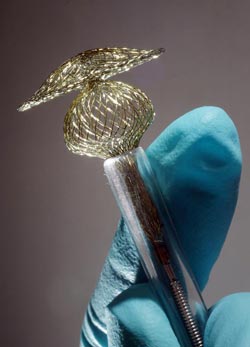Metal in the heart is non-hazardous to health

An occluder made of a nickel-titanium alloy. These medical implants are used for the correction of a defective cardiac septum.<br><br>Photo: Jan-Peter Kasper/FSU<br>
A trousers button, a coin or a watch can be dangerous for people with a nickel allergy. Approximately 1 in 10 Germans is allergic to the metal. “This raises the question of the safety of medical implants containing nickel,” explains Professor Dr. Markus Rettenmayr of the Friedrich-Schiller-Universität Jena.
Nickel-titanium alloys are increasingly used as material for cardiovascular implants in minimal invasive surgery. Once implanted, nickel-titanium alloys can release small amounts of nickel due to corrosion phenomena, the holder of the Chair of Metallic Materials explains. Our concern was that this could – in particular over a long period of time – lead to a nickel contamination in the patient’s body that possibly results in health problems.
But these concerns are essentially unfounded: The team of Jena scientists led by Professor Rettenmayr and his colleague Dr. Andreas Undisz report in the current issue of the scientific journal ‘Acta Biomaterialia‘ that the release of nickel from wires made of nickel-titanium alloys is very low, also over longer periods of time. The scientists could back up their statement in the first long-term study ever, which examined such nickel release in detail: The testing period for metal release, as requested for governmental approval of a medical implant, is only a few days. In contrast the Jena research team monitored the release of nickel over a time period of eight months.
Examination objects were fine wires from a superelastic nickel-titanium alloy that are, for example, applied in the form of occluders (these are medical implants used for the correction of a defective cardiac septum). Such occluders often consist of two tiny wire-mesh ”umbrellas”, approximately the size of a 1 Euro coin. The superelastic implant can be mechanically drawn into the shape of a thin thread, which then can be placed in a cardiac catheter. “By that means the occluders can be put into place via minimal invasive surgery,” Dr. Undisz says. Ideally the implant will stay in the patient’s body for years or decades.
Dr. Undisz and the doctoral candidate Katharina Freiberg wanted to find out what happens during this period of time with the nickel-titanium wire. They exposed samples of the wires, which underwent different mechanical and thermal pre-treatment, to highly purified water. They then examined the release of nickel according to pre-defined time intervals. “This wasn’t trivial at all”, Undisz says, “because the concentration of the released metal is often at the limit of detection.” However, in co-operation with scientists from the Institute for Clinical Chemistry and Laboratory Medicine of the Jena University Hospital the materials scientists successfully developed a reliable test routine to measure the process of the nickel release.
“Mostly in the first days and weeks, depending on the pre-treatment of the material, considerable amounts of nickel may get released,” Undisz summarizes the results. According to the materials scientist this is due to the mechanical strain of the implant during the surgery. “The deformation damages the thin layer of oxide covering the material. As a consequence the initial nickel release increases.” In the long run, however, the nickel release decreases to amounts of a few nanograms per day and is hence far below the amount of nickel that we absorb anyway through our food on a daily basis.
Original Publication:
Freiberg KE, Bremer-Streck S, Kiehntopf M, Rettenmayr M, Undisz A: Effect of thermomechanical pre-treatment on short- and long-term Ni release from biomedical NiTi, Acta Biomaterialia (2014), doi: 10.1016/j.actbio.2014.01.003
Contact:
Dr.-Ing. Andreas Undisz
Otto-Schott-Institut für Materialforschung
Friedrich Schiller University Jena
Loebdergraben 32, 07743 Jena
Germany
Phone: ++49 3641 947768
Email: andreas.undisz[at]uni-jena.de
Media Contact
More Information:
http://www.uni-jena.deAll latest news from the category: Materials Sciences
Materials management deals with the research, development, manufacturing and processing of raw and industrial materials. Key aspects here are biological and medical issues, which play an increasingly important role in this field.
innovations-report offers in-depth articles related to the development and application of materials and the structure and properties of new materials.
Newest articles

Properties of new materials for microchips
… can now be measured well. Reseachers of Delft University of Technology demonstrated measuring performance properties of ultrathin silicon membranes. Making ever smaller and more powerful chips requires new ultrathin…

Floating solar’s potential
… to support sustainable development by addressing climate, water, and energy goals holistically. A new study published this week in Nature Energy raises the potential for floating solar photovoltaics (FPV)…

Skyrmions move at record speeds
… a step towards the computing of the future. An international research team led by scientists from the CNRS1 has discovered that the magnetic nanobubbles2 known as skyrmions can be…





















